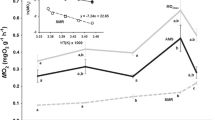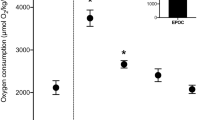Abstract
Maximal rates of oxygen consumption in vitro have been measured under standardized conditions at three test temperatures (5°, 15°, and 25°C) on minced preparations of white muscle from 39 species of shallow-water marine teleost fishes. These fishes came from four different geographic areas, two with cool average water-temperatures (near 15°C: coastal southern California, Galápagos Islands) and two with warm average water-temperatures (near 25°C: Hawaiian Islands; Bermuda). The group includes species covering much of the range of variation to be found among the teleosts with respect to five additional variables: phylogenetic position, type of environment, body weight, activity level, and growth stage. The purpose of the work is to provide part of a base line of tissue-metabolism data on shallow-water fishes for comparison with similar results from deep-sea species. Major conclusions from statistical analyses of the results are: four groups of shapes of oxygen-uptake rate versus temperature curves exist: normal, flat, dipped and peaked. Over 50% of curves are normal. Intra-group differences, contributing significantly to the total variance of the results at given test temperatures, are: cool versus warm average environmental temperatures primarily for epipelagic species; epipelagic versus non-epipelagic environments; very active species versus all others; juvenile stages versus adults. In each case, the subgroup first mentioned shows higher muscle oxygen-uptake rates than the other subgroup. Variables not contributing significantly to the total variance are phylogenetic position and body weight. Physiological and ecological implications of these results are discussed.
Similar content being viewed by others
Literature cited
Aron W. and R. H. Goodyear: Fishes collected during a midwater trawling survey of the Gulf of Elat and the Red Sea. Israel J. Zool. 18, 237–244 (1969).
Barlow, G. W.: Intra- and interspecific differences in rate of oxygen consumption in gobiid fishes of the genus Gillichthys. Biol. Bull. mar. biol. Lab., Woods Hole 121, 209–229 (1961).
Barnhart, P. S.: Marine fishes of southern California, 209 pp. Berkeley: University of California Press 1936.
Böhlke, J. E. and C. C. G. Chaplin: Fishes of the Bahamas, 771 pp. Philadelphia: Academy of Natural Sciences 1968.
Brauer, R. (Ed.): Proceedings of workshop conference on high pressure aquaria. Chapel Hill: University of North Carolina Press. (In press).
Braun, K., H. Künneman und H. Laudien: Der Einfluß von Temperaturänderungen auf Enzyme der Fischmuskulatur. Versuche mit Rhodeus amarus. Mar. Biol. 7, 59–70 (1970).
Breder, C. M.: On the taxonomy and the postlarval stages of the surgeonfish, Acanthurus hepatus. Copeia 1949 (4), p. 296 (1949).
Caldwell, R. S.: Thermal compensation of respiratory enzymes in tissues of the goldfish (Carassius auratus L.) Comp. Biochem. Physiol. 31, 79–93 (1969).
Dean, J. M.: The metabolism of tissues of thermally acclimated trout (Salmo gairdneri). Comp. Biochem. Physiol. 29, 185–196 (1969).
Denton, E.: The buoyancy of fish and cephalopods. Prog. Biophys. biophys. Chem. 11, 177–234 (1961).
Denton, E.: The buoyancy of fish and cephalopods. Prog. Biophys. biophys. Chem. 11, 177–234 (1961).
Edwards, R. R. C., J. H. S. Blaxter, U. K. Gopalan and C. V. Mathew: A comparison of standard oxygen consumption of temperate and tropical bottom-living marine fish. Comp. Biochem. Physiol. 34, 491–495 (1970).
Ekberg, D. R.: Respiration in tissues of goldfish adapted to high and low temperatures. Biol. Bull. mar. biol. Lab., Woods Hole 114, 308–316 (1958).
Evans, R. M., F. C. Purdie and C. P. Hickman, Jr.: The effect of temperature and photoperiod on the respiratory metabolism of rainbow trout (Salmo gairdneri). Can. J. Zool. 40, 107–118 (1962).
Flügel, H. and C. Schlieper: The effects of pressure on marine invertebrates and fishes. In: High pressure effects on cellular processes, pp 211–234. Ed. by A. M. Zimmerman. New York: Academic Press 1970.
Freeman, J. A.: Oxygen consumption, brain metabolism and respiratory movements of goldfish during temperature acclimatizations, with special reference to lowered temperatures. Biol. Bull. mar. biol. Lab., Woods Hole 99, 416–424 (1950).
Fuhrman, F. A., N. Hollinger, J. M. Crisman, J. Field II and F. W. Weymouth: The metabolism of the excised brain of the largemouthed bass (Huro salmoides) at graded temperature levels. Physiol. Zoöl. 17, 42–50 (1944).
Gordon, M. S.: Oxygen consumption of red and white muscles from tuna fishes. Science, N.Y. 159, 87–90 (1968).
—: Hydrostatic pressure. In: Fish physiology, Vol. 4 pp. 445–464. Ed. by W. S. Hoar and D. J. Randall. New York: Academic Press 1970a.
—: Temperature and hydrostatic pressure effects on fish tissue metabolism. Fedn Proc. Fedn Am. Socs exp. Biol. 29, p. 846 (Abstr.) (1970b).
Gosline, W. A. and V. E. Brock, Handbook of Hawaiian fishes, 372 pp. Honolulu: University of Hawaii Press 1965.
Graham, J. B.: Temperature sensitivity of two species of intertidal fishes. Copeia 1970 (1), 49–56 (1970).
Greenwood, P. H., D. E. Rosen, S. H. Weitzman and G. S. Myers: Phyletic studies of teleostean fishes, with a provisional classification of living forms. Bull. Am. Mus. nat. Hist. 131, 339–456 (1966).
Hazel, J. and C. L. Prosser: Interpretation of inverse acclimation to temperature. Z. vergl. Physiol. 67, 217–228 (1970).
Hochachka, P. W. and F. R. Hayes: The effects of temperature acclimation on pathways of glucose metabolism in the trout. Can. J. Zool. 40, 261–270 (1962).
— and G. N. Somero: The adaptation of enzymes to temperature. Comp. Biochem. Physiol. 27, 659–668 (1968).
Holmes, W. N. and E. M. Donaldson: The body compartments and the distribution of electrolytes. In: Fish physiology, Vol. 1 pp 1–89. Ed. by W. S. Hoar and D. J. Randall. New York: Academic Press 1969.
Hubbs, C. L.: Dikellorhynchus and Kanazawaichthys: nominal fish genera interpreted as based on prejuveniles of Malacanthus and Antennarius, respectively. Copeia 1958 (4), 282–285 (1958).
Hunter, J. R.: Lolor changes of pelagic prejuvenile goatfish, Pseudupeneus grandisquamis, after confinement in a shipboard aquarium. Copeia 1967 (4), 850–852 (1967).
Job, S. V.: The respiratory metabolism of Tilapia mossambica (Teleostei). I, The effect of size. temperature and salinity. Mar. Biol. 2, 121–126 (1969).
Kanungo, M. S. and C. L. Prosser: Physiological and biochemical adaptation of goldfish to cold and warm temperatures. II. Oxygen consumption of liver homogenate; oxygen consumption and oxidative phosphorylation of liver mitochondria. J. cell. comp. Physiol. 54, 265–274 (1959).
Krebs, H. A.: Body size and tissue respiration. Biochim. biophys. Acta 4, 249–269 (1950).
Künnemann, H., H. Laudien und H. Precht: Der Einfluß von Temperaturänderungen auf Enzyme der Fischmuskulatur. Versuche mit Goldorfen Idus idus. Mar. Biol. 7, 71–81 (1970).
Marshall, N. B.: Swimbladder structure of deep-sea fishes in relation to their systematics and biology. “Discovery” Rep. 31, 1–122 (1960).
Morris, R. W.: Distribution and temperature sensitivity of some eastern Pacific cottid fishes. Physiol. Zoöl. 34, 217–227 (1961).
Peiss, C. N. and J. Field: The respiratory metabolism of excised tissues of warm and cold adapted fishes. Biol. Bull. mar. biol. Lab., Woods Hole 99, 213–224 (1950).
Pequignot, J.: La respiration tissulaire chez les poissons: Étude des conditions optimales pour obtenir et mesurer une “respiration potentielle” sur broyats tissulaires. Experientia 20, 221–222 (1964).
Prosser, C. L.: Metabolic and central nervous acclimation of fish to cold. In: The cell and environmental temperature, pp 375–383. Ed. by A. S. Troshin: Oxford: Pergamon Press 1967.
Roberts, J. L.: Metabolic responses of fresh-water sunfish to seasonal photoperiods and temperatures. Helgoländer wiss. Meeresunters. 9, 459–473 (1964).
—: Systemic versus cellular acclimation to temperature by poikilotherms. Helgoländer wiss. Meeresunters. 14, 451–465 (1966).
—: Metabolic compensations for temperature in sunfish. In: Molecular mechanisms of temperature adaptation, pp 245–262. Ed. by C. L. Prosser. Washington, D. C.: Am. Ass. Adv. Science 1967.
Roedel, P. M.: Common ocean fishes of the California coast. Fish Bull. Calif. 91, 1–184 (1953).
Sale, P. F.: Distribution of larval Acanthuridae off Hawaii. Copeia 1970 (4), 765–766 (1970).
Scheffé, H.: The analysis of variance, 450 pp. New York: J. Wiley & Sons 1959.
Scholander, P. F., W. Flagg, V. Walters and L. Irving: Climatic adaptation in arctic and tropical poikilotherms. Physiol. Zoöl. 26, 67–92 (1953).
— and O. Iversen: New design of volumetric respirometer. Scand. J. clin. Lab. Invest. 10, 429–431 (1958).
Somero, G. N.: Enzyme mechanisms of temperature compensation: immediate and evolutionary effects of temperature on enzymes of aquatic poikilotherms. Am. Nat. 103, 517–530 (1969).
— and P. W. Hochachka: Biochemical adaptation to the environment. Am. J. Zool. 11, 159–167 (1971).
Suhrman, R.: Weitere Versuche über die Temperatur Adaptation der Karauschen (Carassius vulgaris Nils). Biol. Zbl. 74, 432–448 (1955).
Vernberg, F. J.: The respiratory metabolism of tissues of marine teleosts in relation to activity and body size. Biol. Bull. mar. biol. Lab., Woods Hole 106, 360–370 (1954).
— and I. E. Gray: A comparative study of the respiratory metabolism of excised brain tissue of marine teleosts. Biol. Bull. mar. biol. Lab., Woods Hole 104, 445–449 (1953).
Wittenberger, C.: Biologie du chinchard de la Mer Noire (Trachurus mediterraneus ponticus) XV. Recherches sur le metabolisme d'effort chez Trachurus et Gobius. Mar. Biol. 2, 1–4 (1968).
— and L. V. Diaciuc: Effort metabolism of lateral muscles in carp. J. Fish. Res. Bd Can. 22, 1397–1406 (1965).
Author information
Authors and Affiliations
Additional information
Communicated by J. Bunt, Miami
Rights and permissions
About this article
Cite this article
Gordon, M.S. Comparative studies on the metabolism of shallow-water and deep-sea marine fishes. I. White-muscle metabolism in shallow-water fishes. Mar. Biol. 13, 222–237 (1972). https://doi.org/10.1007/BF00391380
Accepted:
Issue Date:
DOI: https://doi.org/10.1007/BF00391380




